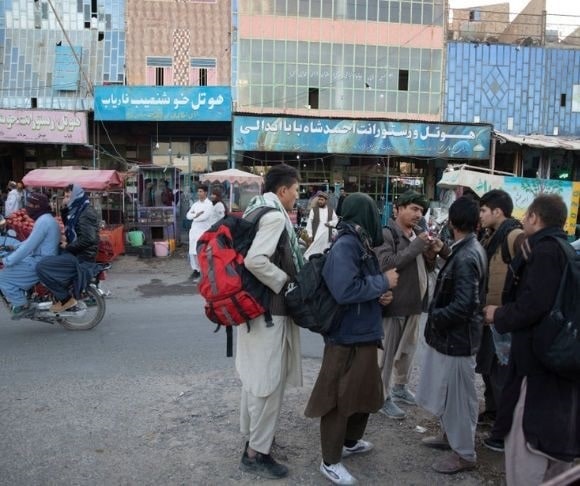We have seen this movie before. The scene is tarmac in Afghanistan with U.S. soldiers boarding chartered U.S. commercial airliners, military cargo aircraft, and troop-carrying helicopters in the dead of night beating feet to get out of Dodge. It appears to be an unseemly departure from a war without a satisfactory result. The mental image raises the comparison between America’s withdrawal from Afghanistan and the last days of South Vietnam, 1975.
 It’s because any exit by American troops during continued fighting will have the stain of unfinished work and a precipitous retreat. One thinks of the iconic April 29, 1975, Associated Press photo by the late Dutch photojournalist Hubert van Es showing South Vietnamese scrambling to get on the last helicopter out of Saigon departing from a hotel roof a half-mile from the U.S. Embassy. Could this be a harbinger of things to come in Kabul, Afghanistan?
It’s because any exit by American troops during continued fighting will have the stain of unfinished work and a precipitous retreat. One thinks of the iconic April 29, 1975, Associated Press photo by the late Dutch photojournalist Hubert van Es showing South Vietnamese scrambling to get on the last helicopter out of Saigon departing from a hotel roof a half-mile from the U.S. Embassy. Could this be a harbinger of things to come in Kabul, Afghanistan?
Unfortunately, what we are learning from U.S. military commanders and the Pentagon is that something similar is possibly on the horizon. Taliban forces are quickly gaining ground throughout the regions outside the Afghan capital. Reporting for U.S. Naval Institute News, John Grady described the views of Carter Malkasian, a special assistant to the former chairman of the joint chiefs of staff, Marine Corps General Joseph Dunsford. Regarding the U.S. departure from Afghanistan, Grady explained:
“The American withdrawal is now 90 percent complete, according to the Pentagon. About 650 U.S. forces are expected to remain in the country to protect the American embassy, and for the time being, Kabul’s airport, when the pullout is complete in late August. With Taliban military pressure increasing on provincial capitals and cities, the ability of the Afghan government under President Ashraf Ghani to stand on its own ‘doesn’t look good,’ as American and NATO forces withdraw, Malkasian said.”
For Afghan forces left to fend for themselves against the Taliban, the hope of having U.S. airstrikes to support them dimmed considerably, according to the commander of U.S. Central Command, Marine Corps General Frank McKenzie. McKenzie told Voice of America’s Carla Babb that U.S. forces are not intending to provide airstrikes when U.S. ground troops are pulled out. Babb points out that any airstrike for “counterterrorism strikes in Afghanistan will be limited to instances when attack plans have been discovered to strike the U.S. homeland or the homelands of our allies.” Consequently, any immediate air support for Kabul’s military is unlikely.
Without air cover, how dire is it for Afghanistan’s military? Liberty Nation’s Mark Angelides explains that, without “decisive airpower,” the Afghan military’s future is grim. Sky News journalists Alex Crawford and Kevin Sheppard paint a dark picture having interviewed Taliban fighters at Sultan Khil military base in Wardak Province, “days after they had captured it.” According to the reporters, the Taliban were on the march and capturing territory at an “astonishing rate.” Regarding the military base they visited:
“It not only represented a significant military success for the Taliban after two days of fighting with Afghan soldiers, but it also provided them with a treasure trove of armory and ammunition. The commander accompanying us said his fighters had taken 70 sniper rifles, 900 guns, 30 Humvees, 20 army pickups, and 15 articulated military trucks. Taliban fighters showed us shipping container after shipping container on the base stashed full of the world’s most developed weapons. There were satellite phones, grenades, mortars, bullets, empty containers for sniper rifles, and a range of ammunition. Many had labels on the front saying: ‘Property of USA Government.'”
Nonetheless, President Joe Biden on July 8 announced to the American people that:
“I intend to maintain our diplomatic presence in Afghanistan, and we are coordinating closely with our international partners in order to continue to secure the international airport. And we’re going to engage in a determined diplomacy to pursue peace and a peace agreement that will end this senseless violence.”
The Biden administration’s enthusiasm for a negotiated solution is not necessarily shared by the Taliban fighters, as we learned from Sky News. On the contrary, the Taliban seem to be doing just fine without negotiating. Raising the antenna of critics was Biden’s comment about ensuring that the international airport remains open, no doubt as means for American government workers to make a hasty departure – only if negotiations fail, of course.
As part of the Afghanistan withdrawal plan, having many helicopters standing by would be a good hedge against a breakdown in negotiations. Otherwise, the consequence could be the scene depicted in the April 29, 1975, photo of South Vietnam civilians attempting to scale the 14-foot wall around the U.S. embassy in Saigon, only fast forward to today in Kabul.
The views expressed are those of the author and not of any other affiliation.
~
Read more from Dave Patterson.




